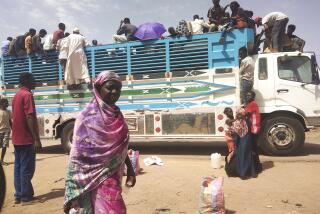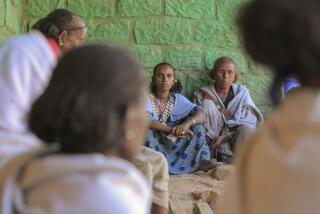Fierce Winter Brings Crisis to Mongolian Nomads
- Share via
BAYANJARGALAN, Mongolia — The animals that are Mongolia’s lifeblood are dying. Vultures and crows tear at frost-stiffened sheep carcasses scattered across the snowy steppe. Dogs hungrily circle dying cattle, waiting to feed.
In one of Mongolia’s deadliest winters in 50 years, 1.3 million head of livestock are dead, impoverishing nomadic herders who rely on their animals for everything, the United Nations reports. It says that by May, 6.6 million animals--21% of Mongolia’s herds--could perish in a slow-motion disaster overshadowed by devastating earthquakes in India and El Salvador.
People aren’t dying of hunger yet, but the United Nations expects death rates among children, women and the elderly to climb as malnutrition and disease take their toll. The struggle to keep animals alive and watching them die is mentally, physically and financially exhausting herders.
Nature, man and politics combined have worsened the crisis. Bitter cold and heavy snows after a summer drought that baked lush pastures left animals with little to eat. Mongolia’s peaceful switch to democracy and market economics 11 years ago has left the vast but poor nation ill equipped to cope.
A third of Mongolia’s 2.4 million people are nomadic herders, living a pastoral existence in some ways little changed from when Mongol conqueror Genghis Khan forged one of the world’s largest empires 800 years ago.
Animals’ meat, milk, wool and skins provide nomads with food, clothes, leather and goods to trade. Dried-out dung is burned for cooking and for heating “gers,” the nomads’ round, felt-lined tent homes. For many herders, animals are the only form of transport across the boundless steppe.
Killing a nomad’s herd is roughly equivalent to taking away a Western family’s car and bank account, emptying its refrigerator and switching off the heat.
Some families may never recover.
“It’s the loss of a whole way of life and culture that has existed for centuries,” said Saraswathi Menon, the top U.N. official in Mongolia. Some herders have committed suicide, she added.
Even before this winter, Dolgorsuren’s family was poor. Now its seven members are struggling to survive. Frozen sheep lie piled up behind their ger. A dog gnaws at a dead cow out front.
“I’ve never seen such a cold and severe winter. I have been taking care of sheep since I was 9 years old. There have been cold, hard winters, but none as hard as this,” says Dolgorsuren, a 64-year-old grandmother, who like many Mongolians uses only one name. “We don’t know how we’ll survive.”
In Mongolia, families with fewer than 20 animals per person are considered poor. Before this winter, Dolgorsuren’s family had 149 animals, about 21 each. By early February, just 60 were left and many are expected to die. The family has no money for fodder or coal, forcing them to spend hours each day scavenging the surrounding treeless hills for twigs and kindling.
Last year, when another bitter winter killed 3 million animals and stripped 2,400 herding families of all their livestock, the Dolgorsuren family lost one of their gers in a storm. All seven now sleep in one small, dilapidated ger, the children huddled on the floor.
On this day, lunch is a half-dozen patties of flour and water and greasy hunks of boiled beef and horse. One of the children, Togtokh, says he is 16 but looks no older than 12--a possible sign of stunting caused by long-term malnutrition.
But in some ways, this family is lucky. Their ger is planted close enough to the hamlet of Bayanjargalan, about 100 miles southeast of the capital, Ulan Bator, for aid to reach them. The grandmother says they got two bales of hay, rice and flour.
Snows cut other families off entirely. In Sergelen, a hamlet about 40 miles south of Ulan Bator, government official D. Tomor frets that he hasn’t been able to reach some families for two weeks. Even if he could, he has no aid to give them.
“We don’t know how they are surviving,” he says. “I’m very worried.”
In the communist era, when Mongolia’s herds were collectivized, the district used tractors and hay-making machines to prepare 2,000 to 3,000 tons of hay for winter, Tomor says.
But since herds were privatized in 1991 and animals distributed to herders, the machines have fallen into disrepair. Last summer, the district’s herders prepared just 50 tons of hay, Tomor says. With no coal, the district school has closed, he adds.
Nationally, just 59% of the hay and 21% of the fodder the government said would be needed for winter was prepared by October, according to the United Nations.
It has appealed for $11.7 million worth of aid to provide hay, food and other assistance.
Overgrazing may have worsened the disaster. Nomadic herds grew more than 25% in six years, from 26 million animals in 1992 to 33 million in 1998. Wells and other infrastructure were neglected as state-run collectives broke up. Herders gathered flocks around wells that still worked, causing overgrazing and spreading diseases among herds.
“I’m losing hope for a good life,” says Batmonkh, a 40-year-old herder who says two or three of his animals have been dying each day. He says he can’t afford to clothe his five children or to get medical care.
His remaining 20 cows “have already lost their strength. It’s a long time to go until summer. By then we’ll have no animals left,” Batmonkh says. “The dogs and crows are getting fat.”
*
ReliefWeb: https://www.reliefweb.int/w/rwb.nsf
United Nations site on Mongolia: https://www.un-mongolia.mn/main.html
More to Read
Sign up for Essential California
The most important California stories and recommendations in your inbox every morning.
You may occasionally receive promotional content from the Los Angeles Times.













